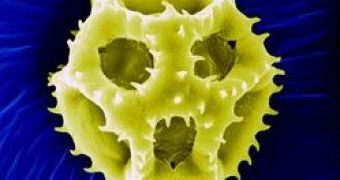Inserting a gene into a cell is hard work. But it is even harder when it's about a plant cell.
Now a team of Iowa State University has managed to do it and to trigger the gene's expression with controlled precision by using nanotechnology, a fact that could boost it as a novel powerful tool for delivery processes into plant cells. Other approaches, too, managed to deliver a gene into a plant cell, but the chemicals proved to be toxic and the process lacked precision.
"With the mesoporous nanoparticles, we can deliver two biogenic species at the same time. We can bring in a gene and induce it in a controlled manner at the same time and at the same location. That's never been done before." said Kan Wang, professor of agronomy and director of the Center for Plant Transformation, Plant Sciences Institute.
This eases the study of gene function in plants but also the delivery of chemicals inside cell walls, helping the investigation of intracellular events.
The team used porous, silica nanoparticles, which are spherical and with arrays of independent porous channels, forming a honeycomb-like structure. These can be loaded with molecules.
"One gram of this kind of material can have a total surface area of a football field, making it possible to carry a large payload," Trewyn said.
The nanoparticle can "cap" the molecules inside and can be activated to release their cargo inside of cells, offering a total control for scheduling the delivery. The first attempt of using the silica nanoparticle failed due to the rigid cellulose wall of the plant cell.
In animals cells, which lack the walls, it is much easier: the nanoparticles enter the cells through endocytosis (molecules from outside are swallowed by the cell membrane). Removing the wall of the plant cell did not work, so the researchers chose to add the surface of the nanoparticles a chemical coating.
"The team found a chemical we could use that made the nanoparticle look yummy to the plant cells so they would swallow the particles," said co-author Francois Torney, from Biogemma, Clermond-Ferrand, France.
The new nanoparticles were engulfed by the plant protoplasts (a type of plant cells lacking the cellulose walls). To introduce the DNA molecule into walled plant cells, the researchers covered the silica nanoparticles with even smaller gold particles, which made them heavier, enabling their introduction into the plant cell with the standard gene gun. By now, the technology successfully worked with Arabidopsis, tobacco and corn.
"The most tremendous advantage is that you can deliver several things into a plant cell at the same time and release them whenever you want," said Torney.
"Until now, you were at nature's mercy when you delivered a gene into a cell. There's been no precise control as to whether the cells will actually incorporate the gene and express the consequent protein. With this technology, we may be able to control the whole sequence in the future." said co-author Victor Lin, professor of chemistry and senior scientist, U.S. Department of Energy's Ames Laboratory.
"We really don't know what's going on inside the cell. This gets us inside where we can study the biology per se," added Wang.

 14 DAY TRIAL //
14 DAY TRIAL //